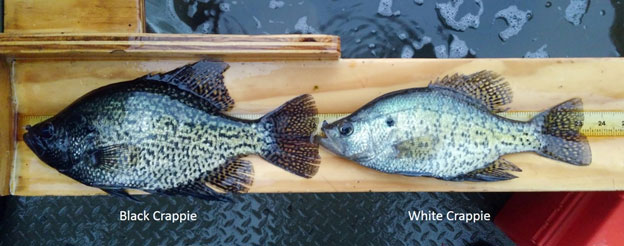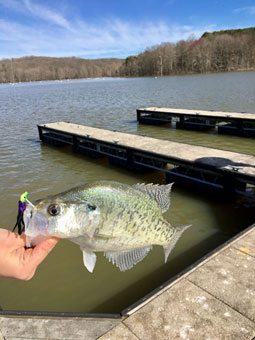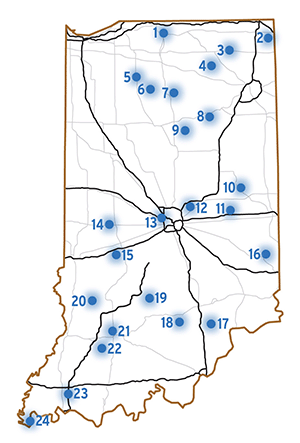
Overview
Indiana is home to two species of crappie: black crappie (Pomoxis nigromaculatus) and white crappie (Pomoxis annularis; hereafter referred to as crappies). Both are commonly referred to as panfish and can be found in many of Indiana’s streams, ponds, and lakes. The two species have some differences in water quality preferences but due to their similarities they are managed jointly with a 25-fish daily bag limit.

Crappies diets consist mostly of smaller fish (e.g., minnows), but will also feed on aquatic insects, larvae, worms, and crayfish. Spawning takes place in late April and May when water temperature reaches about 55°F. The male fans out a depression with his caudal fin in 3-10 feet of water. Female crappies enter the spawning area and deposit their eggs in one or more of the nests, which are immediately fertilized by the male fish. The number of eggs in a crappie nest is variable, but a nest can hold up to 20,000. It is practically impossible to distinguish the males from the females, even just before spawning.
Crappie are an excellent eating fish that are easy to catch and clean. Crappie fishing is best during the spring and fall when crappie move into shallower water and can be caught by using jigs or live bait. Focus fishing efforts on areas of sunken logs, standing timber, brush piles, or docks.

Management
Many states have crappie regulations such as a reduced bag limit or minimum length limits. Indiana has a 25 fish daily bag limit but does not have statewide crappie size regulation. However, some lakes in Indiana may benefit from a minimum length limit. Those lakes are usually frequently fished, have fast-growing fish, and have consistent production of young fish; however, most of Indiana’s lakes don’t fit these criteria. For many Indiana lakes, a minimum length limit would result in poorer fishing. Fewer fish would be harvestable because more fish would depend on limited resources, which would result in slower growth and stockpiling of many small fish.
DNR fisheries biologists are committed to creating excellent fishing experiences for Indiana anglers. As part of that effort, DNR fisheries biologists are working to identify which lakes would benefit from new crappie fishing regulations. Dogwood and Hardy lakes are currently being monitored under a 9-inch minimum length limit to evaluate whether crappie populations are improving. As more lakes are identified that meet the criteria, DNR fisheries biologists will evaluate the potential benefits of reduced bag and minimum length limits at those lakes.
Regulations
| Species | Daily Bag Limit | Minimum Size |
|---|---|---|
| Crappie (statewide) | 25 | None* |
| Crappie (Ohio River) | 30 | None |
| * 9-inch minimum size at Dogwood Lake (Daviess County) and Hardy Lake (Scott County). | ||
Surveys of the best lakes for crappie fishing

Select link for survey report. Not all lakes have a report available.
- Worster Lake
- Hamilton Lake
- Sylvan Lake
- Webster Lake
- Bass Lake
- Bruce Lake
- Lake Manitou
- Salamonie Lake
- Mississinewa Lake
- Prairie Creek Reservoir
- Westwood Run Lake
- Geist Lake
- Eagle Creek Reservoir
- Raccoon Lake (Cecil M. Harden)
- Cagles Mill Lake
- Brookville Lake
- Hardy Lake
- Starve Hollow Lake
- Monroe Lake
- Thousand Islands Pit
- West Boggs Lake
- Dogwood Lake
- Loon and Otter pits
- Hovey Lake
